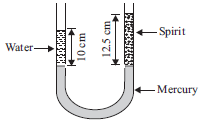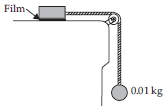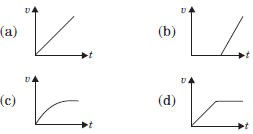Refer to CBSE Class 11 Physics Mechanical Properties of Fluids MCQs Set B provided below available for download in Pdf. The MCQ Questions for Class 11 Physics with answers are aligned as per the latest syllabus and exam pattern suggested by CBSE, NCERT and KVS. Chapter 9 Mechanical Properties of Fluids Class 11 MCQ are an important part of exams for Class 11 Physics and if practiced properly can help you to improve your understanding and get higher marks. Refer to more Chapter-wise MCQs for CBSE Class 11 Physics and also download more latest study material for all subjects
MCQ for Class 11 Physics Chapter 9 Mechanical Properties of Fluids
Class 11 Physics students should refer to the following multiple-choice questions with answers for Chapter 9 Mechanical Properties of Fluids in Class 11.
Chapter 9 Mechanical Properties of Fluids MCQ Questions Class 11 Physics with Answers
Question: Two small spherical metal balls, having equal masses, are made from materials of densities r1 and r2(r1= 8r2) and have radii of 1mm and 2 mm, respectively. They are made to fall vertically (from rest) in a viscous medium whose coefficient of viscosity equals h and whose density is 0.1 r2. The ratio of their terminal velocities would be
a) 79/72
b) 19/36
c) 39/72
d) 79/36
Answer: d
Question: Water is flowing through a horizontal pipe having a restriction, then
a) pressure will be greater at the restriction.
b) pressure will be greater in the wider portion.
c) pressure will be same throughout the length of the pipe.
d) None of the options
Answer: b
Question: A soap bubble, having radius of 1 mm, is blown from a detergent solution having a surface tension of 2.5 × 10–2 N/m. The pressure inside the bubble equals at a point Z0 below the free surface of water in a container. Taking g = 10 m/s2, density of water = 103 kg/m3, the value of Z0 is
a) 0.5 cm
b) 100 cm
c) 10 cm
d) 1 cm
Answer: d
Question: A small sphere of radius ‘r’ falls from rest in a viscous liquid. As a result, heat is produced due to viscous force. The rate of production of heat when the sphere attains its terminal velocity, is proportional to
a) r3
b) r2
c) r5
d) r4
Answer: c
Question: A ring is cut from a platinum tube 8.5 cm internal and 8.7 cm external diameter. It is supported horizontally from the pan of a balance, so that it comes in contact with the water in a glass vessel.If an extra 3.97. If is required to pull it away from water, the surface tension of water is
a) 72 dyne cm–1
b) 70.80 dyne cm–1
c) 63.35 dyne cm–1
d) 60 dyne cm–1
Answer: a
Question: A wind with speed 40 m/s blows parallel to the roof of a house. The area of the roof is 250 m2. Assuming that the pressure inside the house is atmospheric pressure, the force exerted by the wind on the roof and the direction of the force will be (rair = 1.2 kg/m3)
a) 2.4 × 105 N, upwards
b) 2.4 × 105 N, downwards
c) 4.8 × 105 N, downwards
d) 4.8 × 105 N, upwards
Answer: a
Question: A fluid is in streamline flow across a horizontal pipe of variable area of cross section. For this which of the following statements is correct?
a) The velocity is maximum at the narrowest part of the pipe and pressure is maximum at the widest part of the pipe.
b) Velocity and pressure both are maximum at the narrowest part of the pipe.
c) Velocity and pressure both are maximum at the widest part of the pipe.
d) The velocity is minimum at the narrowest part of the pipe and the pressure is minimum at the widest part of the pipe.
Answer: a
Question: A U tube contains water and methylated spirit separated by mercury. The mercury columns in the two arms are at the same level with 10 cm of water in one arm and 12.5 cm of spirit in the other as shown in figure.

The relative density of the spirit is
a) 0.6
b) 0.8
c) 1.0
d) 1.25
Answer: b
Question: The excess pressure inside the first soap bubble is three times that inside the second bubble then, the ratio of volume of the first to the second bubble will be :
a) 1 : 27
b) 3 : 1
c) 1 : 3
d) 1 : 9
Answer: a
Question: Two small drops of mercury, each of radius R coalesce to form a single large drop. The radio of the total surface energies before and after the change is :
a) 1 : 21/3
b) 21/3 : 1
c) 2 : 1
d) 1 : 2
Answer: b
Question: Which of the following figure shown below is correct regarding the steady flow of a non viscous liquid?

Answer: a
Question: The lift of an air plane is based on
a) Torricelli's theorem
b) Bernoulli's theorem
c) Law of gravitation
d) Conservation of linear momentum
Answer: b
Question: The excess pressure inside a spherical drop of water is four times that of another drop. Then their respective mass ratio is
a) 1 : 16
b) 8 : 1
c) 1 : 4
d) 1 : 64
Answer: d
Question: The surface tension of soap solution at a temperature 20°C is 2.5 × 10–2 N m–1. The excess pressure inside a bubble of soap solution of radius 6 mm is
a) 12.5 Pa
b) 14.2 Pa
c) 15.5 Pa
d) 16.7 Pa
Answer: d
Question: In old age arteries carrying blood in the human body become narrow resulting in an increase in the blood pressure. This follows from
a) Pascal’s law
b) Stokes’ law
c) Bernoulli’s principle
d) Archimede’s principle
Answer: c
Question: Iceberg floats in sea water with a part of it submerged. The percentage fraction of the ice berg above sea is (Density of ice = 0.9 g cm–3, density of sea water = 1.1 g cm–3)
a) 18%
b) 12%
c) 10%
d) 8%
Answer: a
Question: A capillary tube of radius r is immersed in water and water rises in it to a height h. The mass of the water in the capillary is 5 g. Another capillary tube of radius 2r is immersed in water. The mass of water that will rise in this tube is
a) 2.5 g
b) 5.0 g
c) 10.0 g
d) 20.0 g
Answer: c
Question: A water tank of height 10m, completely filled with water is placed on a level ground. It has two holes one at 3 m and the other at 7 m from its base. The water ejecting from
a) both the holes will fall at the same spot
b) upper hole will fall farther than that from the lower hole
c) upper hole will fall closer than that from the lower hole
d) more information is required
Answer: a
Question: Three liquids of densities r1, r2 and r3 (with r1 > r2 > r3), having the same value of surface tension T, rise to the same height in three identical capillaries. The angles of contact q1, q2 and q3 obey
a) p/2 > q1 > q2>q3 ≥ 0
b) 0 ≤ q1 < q2 < q3 < p/2
c) p/2 < q1 < q2 < q3 < p
d) p > q1 > q2 > q3 > p/2
Answer: b
Question: Water rises to a height h in capillary tube. If the length of capillary tube above the surface of water is made less than h, then
a) water rises upto a point a little below the top and stays there
b) water does not rise at all
c) water rises upto the tip of capillary tube and then starts overflowing like a fountain
d) water rises upto the top of capillary tube and stays there without overflowing.
Answer: d
Question: Along a streamline
a) the velocity of a fluid particle remains constant
b) the velocity of all fluid particles crossing a given position is constant.
c) the velocity of all fluid particles at a given instant is constant.
d) the speed of a fluid particle remains constant.
Answer: b
Question: A metal block of area 0.10 m2 is connected to a 0.010 kg mass via a string that passes over an ideal pulley (considered massless and frictionless) as shown in figure. A liquid with a film thickness of 0.30 mm is placed between the block and the table. When released the block moves to the right with a constant speed of 0.085 m s–1. The coefficient of viscosity of the liquid is (Take g = 9.8 m s–2) Film 0.01 kg

a) 2.45 × 10–3 Pa s
b) 3.45 × 10–3 Pa s
c) 6.45 × 10–3 Pa s
d) 7.45 × 10–3 Pa s
Answer: b
Question: Which of the following statements is incorrect?
a) Blood is more viscous than water.
b) The blood pressure in humans is greater at the feet than at the brain.
c) The angle of contact of mercury with glass is obtuse while that of water with glass is acute.
d) A spinning cricket ball in air follows a parabolic trajectory.
Answer: d
Question: A tall cylinder is filled with viscous oil. A round pebble is dropped from the top with zero initial velocity. From the plots shown, indicate the one that represents the velocity (v) of the pebble as a function of time (t).

Answer: c
Question: Two syringes of different cross section (without needle) filled with water are connected with a tightly fitted rubber tube filled with water. Diameters of the smaller piston and larger piston are 1 cm and 3 cm respectively. If a force of 10 N is applied to the smaller piston then the force exerted on the larger piston is
a) 30 N
b) 60 N
c) 90 N
d) 100 N
Answer: c
Question: Equal volume of two immiscible liquids of densities p and 2p are filled in a vessel as shown in figure. Two small holes are punched at depths h/2 and 3h/2 from the surface of lighter liquid. If v1 and v2 are the velocities of efflux at these two holes, thenv1/v2

a) 1/2√2
b) 1/2
c) 1/4
d) 1/√2
Answer: d
Question: The two femurs each of cross-sectional area 10 cm2 support the upper part of a human body of mass 40 kg. The average pressure sustained by the femurs is (Take g = 10 m s–2)
a) 2 × 103 N m–2
b) 2 × 104 N m–2
c) 2 × 105 N m–2
d) 2 × 106 N m–2
Answer: c
Question: A small ball (menu) falling under graivty in a viscous medium experiences a drag force proportional to the instantaneous speed u such that Fdrag = Ku . Then the terminal speed of the ball within the viscous medium is
a) K/mg
b) mg/K
c) √mg?k
d) (mg/K)2
Answer: a
Question: The water flows from a tap of diameter 1.25 cm with a rate of 5 × 10–5 m3 s–1. The density and coefficient of viscosity of water are 103 kg m–3 and 10–3 Pa s respectively. The flow of water is
a) steady with Reynolds number 5100
b) turbulent with Reynolds number 5100
c) steady with Reynolds number 3900
d) turbulent with Reynolds number 3900
Answer: b
Question: The cylindrical tube of a spray pump has radius R, one end of which has n fine holes, each of radius r. If the speed of the liquid in the tube is V, the speed of the ejection of the liquid through the holes is
a) VR2 /n3r2
b) VR2 /nr
c) VR/n2r2
d) VR/nr
Answer: d
| CBSE Class 11 Physics Motion in a Plane MCQs Set A |
| CBSE Class 11 Physics Motion in a Plane MCQs Set B |
| CBSE Class 11 Physics Motion in a Plane MCQs Set C |
| CBSE Class 11 Physics Work Energy and Power MCQs Set A |
| CBSE Class 11 Physics Work Energy and Power MCQs Set B |
| CBSE Class 11 Physics Work Energy and Power MCQs Set C |
| CBSE Class 11 Physics Systems of Particles and Rotational Motion MCQs Set A |
| CBSE Class 11 Physics Systems of Particles and Rotational Motion MCQs Set B |
| CBSE Class 11 Physics Gravitation MCQs Set A |
| CBSE Class 11 Physics Gravitation MCQs Set B |
| CBSE Class 11 Physics Gravitation MCQs Set C |
| CBSE Class 11 Physics Thermodynamic MCQs Set A |
| CBSE Class 11 Physics Thermodynamic MCQs Set B |
| CBSE Class 11 Physics Thermodynamic MCQs Set C |
| CBSE Class 11 Physics Kinetic Theory MCQs Set A |
| CBSE Class 11 Physics Kinetic Theory MCQs Set B |
| CBSE Class 11 Physics Oscillations MCQs Set A |
| CBSE Class 11 Physics Oscillations MCQs Set B |
| CBSE Class 11 Physics Oscillations MCQs Set C |
| CBSE Class 11 Physics Waves MCQs Set A |
| CBSE Class 11 Physics Waves MCQs Set B |
| CBSE Class 11 Physics Waves MCQs Set C |
| CBSE Class 11 Physics Waves MCQs Set D |
| CBSE Class 11 Physics MCQs Set 1 |
| CBSE Class 11 Physics MCQs Set 2 |
| CBSE Class 11 Physics MCQs Set 3 |
| CBSE Class 11 Physics MCQs Set 4 |
| CBSE Class 11 Physics MCQs Set 5 |
| CBSE Class 11 Physics Physical World MCQs Set A |
| CBSE Class 11 Physics Physical World MCQs Set B |
MCQs for Chapter 9 Mechanical Properties of Fluids Physics Class 11
Expert teachers of studiestoday have referred to NCERT book for Class 11 Physics to develop the Physics Class 11 MCQs. If you download MCQs with answers for the above chapter you will get higher and better marks in Class 11 test and exams in the current year as you will be able to have stronger understanding of all concepts. Daily Multiple Choice Questions practice of Physics will help students to have stronger understanding of all concepts and also make them expert on all critical topics. After solving the questions given in the MCQs which have been developed as per latest books also refer to the NCERT solutions for Class 11 Physics. We have also provided lot of MCQ questions for Class 11 Physics so that you can solve questions relating to all topics given in each chapter. After solving these you should also refer to Class 11 Physics MCQ Test for the same chapter.
You can download the CBSE MCQs for Class 11 Physics Chapter 9 Mechanical Properties of Fluids for latest session from StudiesToday.com
Yes, the MCQs issued by CBSE for Class 11 Physics Chapter 9 Mechanical Properties of Fluids have been made available here for latest academic session
You can find CBSE Class 11 Physics Chapter 9 Mechanical Properties of Fluids MCQs on educational websites like studiestoday.com, online tutoring platforms, and in sample question papers provided on this website.
To prepare for Chapter 9 Mechanical Properties of Fluids MCQs, refer to the concepts links provided by our teachers and download sample papers for free.
Yes, there are many online resources that we have provided on studiestoday.com available such as practice worksheets, question papers, and online tests for learning MCQs for Class 11 Physics Chapter 9 Mechanical Properties of Fluids

